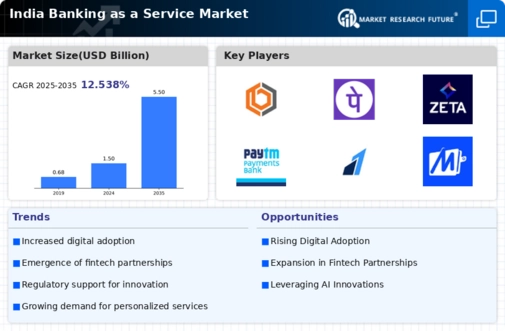The India Banking as a Service (BaaS) market is experiencing rapid evolution, driven by technological advancements and increasing demand for digital financial solutions. This market is characterized by dynamic competition as various businesses strive to provide seamless banking experiences by integrating banking functionalities directly into their applications. This competitive landscape includes a range of players, from established financial institutions to tech startups, all vying for market share and customer loyalty. The evolution of digital payment solutions, coupled with regulatory support for fintech innovations, has created a fertile ground for growth.
Players in this space leverage customer-centric approaches, innovative technologies, and strategic partnerships to differentiate themselves and enhance their service offerings, thus intensifying competition within the sector. Kissht has positioned itself as a prominent player in the India Banking as a Service market, focusing on providing seamless credit solutions tailored for the digital ecosystem. The company has effectively utilized technology to offer instant credit facilities, allowing consumers access to quick loans for a variety of purposes. Kissht's strengths lie in its robust algorithms and data analytics capabilities, which facilitate accurate credit assessments and improve customer experiences.
The company has also built strong partnerships with merchants and retail brands, expanding its reach and establishing a significant market presence. By prioritizing customer convenience and focusing on agile technological adaptations, Kissht continues to enhance its service offerings and maintain competitiveness in the evolving landscape of digital finance in India. Cashfree has made substantial strides in the India Banking as a Service market by delivering a wide array of payment solutions and banking services tailored for businesses.
Known for its reliable payment gateway, Cashfree offers services such as instant refunds, bulk payment processing, and direct bank transfer capabilities, making it an essential choice for online merchants and start-ups in India.
The company showcases strong market presence supported by its focus on integration with multiple platforms, thus ensuring ease of access for users. Cashfree’s strengths further extend to its technology infrastructure, which allows for high transaction volumes and seamless user experiences. Additionally, the company has strategically engaged in various partnerships, enhancing its competitive advantage while exploring potential mergers and acquisitions to expand its footprint in the market. By continuously evolving its product mix and maintaining a strong focus on customer satisfaction, Cashfree has established itself as a formidable player in the Indian Banking as a Service sector.


















Leave a Comment